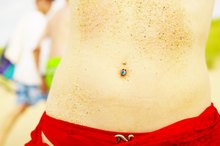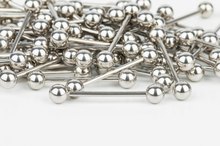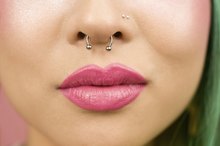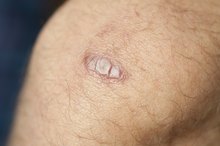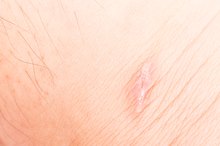What does fact checked mean?
At Healthfully, we strive to deliver objective content that is accurate and up-to-date. Our team periodically reviews articles in order to ensure content quality. The sources cited below consist of evidence from peer-reviewed journals, prominent medical organizations, academic associations, and government data.
- "Western Journal of Medicine;" Common Complications of Body Piercing; Julius Metts; March 2002
- "Western Journal of Medicine;" Common Complications of Body Piercing; Julius Metts; March 2002
The information contained on this site is for informational purposes only, and should not be used as a substitute for the advice of a professional health care provider. Please check with the appropriate physician regarding health questions and concerns. Although we strive to deliver accurate and up-to-date information, no guarantee to that effect is made.
Nose Rings & Keloids
Any time the skin is torn, there is the potential for scarring and other damage. A nose piercing is a significant "tear," going fully through a thick piece of skin, whether it's a nostril piercing or one through the septum. While keloids are most common around ear piercings, they can also form around a nose ring.
Definition
An article by Julius Metts in the "Western Journal of Medicine" describes a keloid as a tumor that forms when the skin's fibrous tissue grows at an abnormal rate in response to an injury 2. Body piercings can cause keloids, as can surgery, cuts, vaccinations and acne. They are more likely to form after injuries of the ear, back and upper chest.
- An article by Julius Metts in the "Western Journal of Medicine" describes a keloid as a tumor that forms when the skin's fibrous tissue grows at an abnormal rate in response to an injury 2.
- Body piercings can cause keloids, as can surgery, cuts, vaccinations and acne.
Risk Factors
How do I Get Gauged Ears Sewn Up?
Learn More
Some people have skin that is naturally predisposed to getting keloids. Those with darker skin, especially of African descent, are particularly vulnerable to their development. If you've gotten keloids before, whether from piercings or other injuries, you should avoid new piercings. Another keloid is likely to form.
- Some people have skin that is naturally predisposed to getting keloids.
- If you've gotten keloids before, whether from piercings or other injuries, you should avoid new piercings.
Characteristics
Keloids will manifest as large discolored bumps next to the piercing hole in the nose. They might itch or even hurt, and the latter is more common if the nostril or septum swells, making the nose ring put more pressure on it. Since there isn't much blood flow to a keloid, their presence can make new piercings take longer to heal, according to the Body Jewellery Shop.
Treatment
How to Get Rid of a Nose Ring Scar
Learn More
Metts says that one treatment for keloids is freezing the skin, then injecting triamcinolone, a steroid, directly into the bump 4. The dermatologist might have to follow up with monthly shots of corticosteroids to completely flatten the keloid. If the cryotherapy and steroids don't work, surgery may be necessary. A shot of triamcinolone would then be injected into the site to keep the keloid from reforming 4.
The Body Jewellery Shop offers more natural treatments 3. It says that soaking the site of the piercing in hot salt water and using compresses can treat keloids. It also reports that many people find that some natural oils, such as tea tree, germseed and even extra virgin olive, will repair scars from nose piercings.
- Metts says that one treatment for keloids is freezing the skin, then injecting triamcinolone, a steroid, directly into the bump 4.
- It also reports that many people find that some natural oils, such as tea tree, germseed and even extra virgin olive, will repair scars from nose piercings.
Prevention
Scarring is more likely to occur the more trauma the skin undergoes. Have your nose pierced by a professional in a sanitary setting, and follow his instructions for care. This will also help prevent infection, which is more common in nose piercings because of the constant presence of mucus in the area.
Even after it is completely healed -- which can take six to 12 weeks, according to Dr. Susan Taylor's website -- keep it protected from being pulled or snagged, for example on clothing. More scar tissue forms with each tear, even if it's a tiny one that you don't notice.
- Scarring is more likely to occur the more trauma the skin undergoes.
- Even after it is completely healed -- which can take six to 12 weeks, according to Dr. Susan Taylor's website -- keep it protected from being pulled or snagged, for example on clothing.
Related Articles
References
- Dr. Susan Taylor's Brownskin.net: Body Piercing
- "Western Journal of Medicine;" Common Complications of Body Piercing; Julius Metts; March 2002
- Body Jewellery Shop: Common Body Piercing Problems
- Drugs.com: Triamcinolone
- "American Family Physician;" Complications of Body Piercing; Donna I. Meltzer, M.D.; Nov. 15, 2005
- Harvard Medical School Harvard Health Publishing. Keloids. Updated April 2019.
- NHS. Keloid scars. Updated June 5, 2019.
- University of Michigan Medicine. Keloid scars.
- Medical University of South Carolina. Scar revision & keloid treatment.
- Westra I, Pham H, Niessen FB. Topical silicone sheet application in the treatment of hypertrophic scars and keloids. The Journal of Clinical and Aesthetic Dermatology. 2016;9(10):28-35.
- NYU Langone Health. Recovery & support for scars & keloids.
- Harvard Medical School Harvard Health Publishing. Keloids. Updated April 2019.
- NHS. Keloid scars. Updated June 5, 2019.
- University of Michigan Medicine. Keloid scars.
- Medical University of South Carolina. Scar revision & keloid treatment.
- Morelli Coppola M, Salzillo R, Segreto F, Persichetti P. Triamcinolone acetonide intralesional injection for the treatment of keloid scars: patient selection and perspectives. CCID. Clin Cosmet Investig Dermatol. 2018;11:387-396. doi:10.2147/CCID.S133672
- Westra I, Pham H, Niessen FB. Topical silicone sheet application in the treatment of hypertrophic scars and keloids. The Journal of Clinical and Aesthetic Dermatology. 2016;9(10):28-35.
- Barara M, Chander R, Mendiratta V. Cryotherapy in treatment of keloids: evaluation of factors affecting treatment outcome. J Cutan Aesthet Surg. 2012;5(3):185-. doi:10.4103/0974-2077.101376
- Rathee M, Kundu R, Tamrakar A. Custom made pressure appliance for presurgical sustained compression of auricular keloid. Ann Med Health Sci Res. 2014;4(8):147-. doi:10.4103/2141-9248.138040
- Xu J, Yang E, Yu N, Long X. Radiation therapy in keloids treatment. Chinese Medical Journal. 2017;130(14):1715-1721. doi:10.4103/0366-6999.209896
- Gauglitz, G. Management of keloids and hypertrophic scars: current and emerging options. Clin Cosmet Investig Dermatol. 2013;6:103–114. doi:10.2147/CCID.S35252
- Shah VV, Aldahan AS, Mlacker S, Alsaidan M, Samarkandy S, Nouri K. 5-fluorouracil in the treatment of keloids and hypertrophic scars: a comprehensive review of the literature. Dermatol Ther (Heidelb). 2016;6(2):169-183. doi:10.1007/s13555-016-0118-5
- Stephanides S, Rai S, August PJ, Ferguson JE, and Madan V. Treatment of refractory keloids with pulsed dye laser alone and with rotational pulsed dye laser and intralesional corticosteroids. Laser Therapy. 2011;20(4):279-286. doi:10.5978/islsm.12-OR-01
- Arno AI, Gauglitz GG, Barret JP, Jeschke MG. Up-to-date approach to manage keloids and hypertrophic scars: a useful guide. Burns. 2014;40(7):1255-1266. doi:10.1016/j.burns.2014.02.011
- Kaiser Permanente. Keloid scars. Updated April 1, 2019.
- NYU Langone Health. Recovery & support for scars & keloids.
- van Leeuwen MCE, Bulstra AEJ, Ket JCF, Ritt MJPF, van Leeuwen PAM, Niessen FB. Intralesional cryotherapy for the treatment of keloid scars. Plastic and Reconstructive Surgery - Global Open. 2015;3(6):e437-. doi:10.1097/GOX.0000000000000348
- Weshahy AH, Abdel Hay R. Intralesional cryosurgery and intralesional steroid injection: a good combination therapy for treatment of keloids and hypertrophic scars. Dermatol Ther. 2012;25(3):273-276. doi:10.1111/j.1529-8019.2012.01456.x
- Wilson, AM. Eradication of keloids: surgical excision followed by a single injection of intralesional 5-fluorouracil and botulinum toxin. Canadian Journal of Plastic Surgery. 2013;21(2):87-91. doi:10.1177/229255031302100208
Writer Bio
Denise Kelly is the copy editor for a small publisher in Paris, France. Before that she was a copy editor at daily newspapers, starting in graduate school. She has been writing professionally since 1996. She has a Master of Science in journalism and a Bachelor of Arts in political science.


